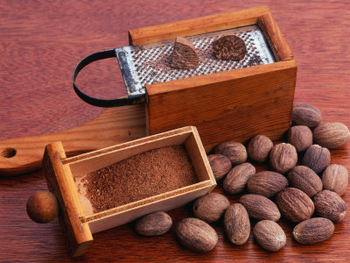Contents:
Common Names | Parts Usually Used | Plant(s) & Culture | Where Found | Medicinal Properties | Biochemical Information
Legends, Myths and Stories | Uses | Formulas or Dosages | How Sold | Warning | Bibliography
Scientific Names

- Myristica fragrans L.
- Myristicaceae
- Nutmeg family
Common Names
- Bishop’s wort
- Black caraway
- Black cumin
- Flower seed
- Jatiphala (Sanskrit name)
- Nigella seed
- Nutmeg flower
- Rou-dou-kou (Chinese name)
- Small fennel flower
Parts Usually Used
Seed
Back to Top

Description of Plant(s) and Culture
Nutmeg is a tropical evergreen tree; the brown, wrinkled, oval fruit contains a kernel which is covered by a bright red membrane. The membrane provides the spice mace, and the kernel the spice nutmeg.
Another variety: The Chinese use a nutmeg (Myristica moschata) that they name Jon-tou-k’ou. Very seldom used as a spice.
Back to Top
Where Found
Native to Indonesia, and cultivated in the West Indies, South Africa, the Molucca Islands, and other tropical areas.
Back to Top
Medicinal Properties
Aphrodisiac, aromatic, astringent, carminative, hallucinogenic, nervine, sedative, stimulant, stomachic
Back to Top
Biochemical Information
Volatile oil consisting of d-camphene, a-pinene, myristicin
Back to Top
Legends, Myths and Stories
Mace (nutmeg tree Myristica fragrans) is the lacy dried aril or outer covering of the seed of the tropical nutmeg tree. The kernel inside the seed is the spice nutmeg. Uses in whole or powdered form: cakes, cookies, cooked fruit, chocolate puddings, and other desserts. It is often combined with bay leaves, cloves, and onions in seasoning dishes. Also, used for flavoring liqueurs and cordials, mulled cider, planter’s punch and hot punch.
First brought to Europe from the Banda Islands by Portuguese sailors in 1512, nutmeg gained the reputation of a cure-all and was widely eaten as a tonic. Was even taken erroneously to procure abortions and was claimed as a cure for the plague. Known as rou dou kou in China, it has been used there since the 7th century.
The Malays believe that nutmeg trees will not bear unless they can hear the sea and the tress must be fed with animal food. The beliefs are corroborated by the fact that trees grown near the sea and fed with animal food actually do produce the finest fruits.
Back to Top
Uses
In small quantities, nutmeg improves appetite and digestion. Used to treat diarrhea, dysentery, gas, colic, nausea, vomiting, impotence, premature ejaculation, muscle spasms, and insomnia. The oil is sometimes used to dispel flatulence. It is a mild hallucinogenic drug, somewhat like marijuana. In addition to hallucinations and elation, however, eating nutmeg produces stomach pain, double vision, delirium, and other symptoms of poisoning. Eating as few as 2 nutmegs can cause death. Externally, the essential oil is used for rheumatic pain and, like clove oil, can be applied as an emergency treatment to dull toothache. In France, it is given in drop doses in honey for digestive upsets and for bad breath.
Back to Top
Formulas or Dosages
Do not boil.
Nutmeg tea: pour 1 pint boiling water over a crushed nutmeg and allow to stand until cool, then strain. Take 1 cupful before retiring to aid in restful sleep.
1/2 to 6 gms. in infusion.
Back to Top
How Sold
Sold as a spice in supermarkets
Back to Top
Warning
It is a mild hallucinogenic drug, somewhat like marijuana. In addition to hallucinations and elation, however, eating nutmeg produces stomach pain, double vision, delirium, and other symptoms of poisoning. Eating as few as 2 nutmegs can cause death. More than 7.5 gms. in a single dose can be toxic, producing convulsions and palpitations. Use only as a seasoning in small amounts, other uses should have medical supervision.
Back to Top
Bibliography
![]() The Complete Medicinal Herbal
The Complete Medicinal Herbal, by Penelope Ody, Dorling Kindersley, Inc, 232 Madison Avenue, New York, NY 10016, First American Edition, copyright 1993
![]() Chinese Medicinal Herbs
Chinese Medicinal Herbs, compiled by Shih-Chen Li, Georgetown Press, San Francisco, California, 1973.
![]() The Herbalist Almanac
The Herbalist Almanac, by Clarence Meyer, Meyerbooks, publisher, PO Box 427, Glenwood, Illinois 60425, copyright 1988, fifth printing, 1994
![]() The Herb Book
The Herb Book, by John Lust, Bantam Books, 666 Fifth Avenue, New York, NY. copyright 1974.
Herbal Gardening, compiled by The Robison York State Herb Garden, Cornell Plantations, Matthaei Botanical Gardens of the University of Michigan, University of California Botanical Garden, Berkeley., Pantheon Books, Knopf Publishing Group, New York, 1994, first edition
![]() Indian Uses of Native Plants
Indian Uses of Native Plants, by Edith Van Allen Murphey, Meyerbooks, publisher, PO Box 427, Glenwood, Illinois 60425, copyright 1958, print 1990
![]() The Nature Doctor: A Manual of Traditional and Complementary Medicine
The Nature Doctor: A Manual of Traditional and Complementary Medicine, by Dr. H.C.A. Vogel; Keats Publishing, Inc., 27 Pine Street (Box 876) New Canaan, CT. 06840-0876. Copyright Verlag A. Vogel, Teufen (AR) Switzerland 1952, 1991
 Old Ways Rediscovered
Old Ways Rediscovered, by Clarence Meyer, Meyerbooks, publisher, PO Box 427, Glenwood, Illinois 60425, published from 1954, print 1988
![]() Planetary Herbology
Planetary Herbology, by Michael Tierra, C.A., N.D., O.M.D., Lotus Press, PO Box 325, Twin Lakes. WI 53181., Copyright 1988, published 1992
![]() Webster’s New World Dictionary
Webster’s New World Dictionary, Third College Edition, Victoria Neufeldt, Editor in Chief, New World Dictionaries: A Division of Simon & Schuster, Inc., 15 Columbus Circle, New York, NY 10023
![]() The Yoga of Herbs: An Ayurvedic Guide to Herbal Medicine
The Yoga of Herbs: An Ayurvedic Guide to Herbal Medicine, by Dr. David Frawley & Dr. Vasant Lad, Lotus Press, Twin Lakes, Wisconsin, Second edition, 1988.
 The Rodale Herb Book: How to Use, Grow, and Buy Nature’s Miracle Plants (An Organic gardening and farming book)
The Rodale Herb Book: How to Use, Grow, and Buy Nature’s Miracle Plants (An Organic gardening and farming book), edited by William H. Hylton, Rodale Press, Inc. Emmaus, PA, 18049., 1974
